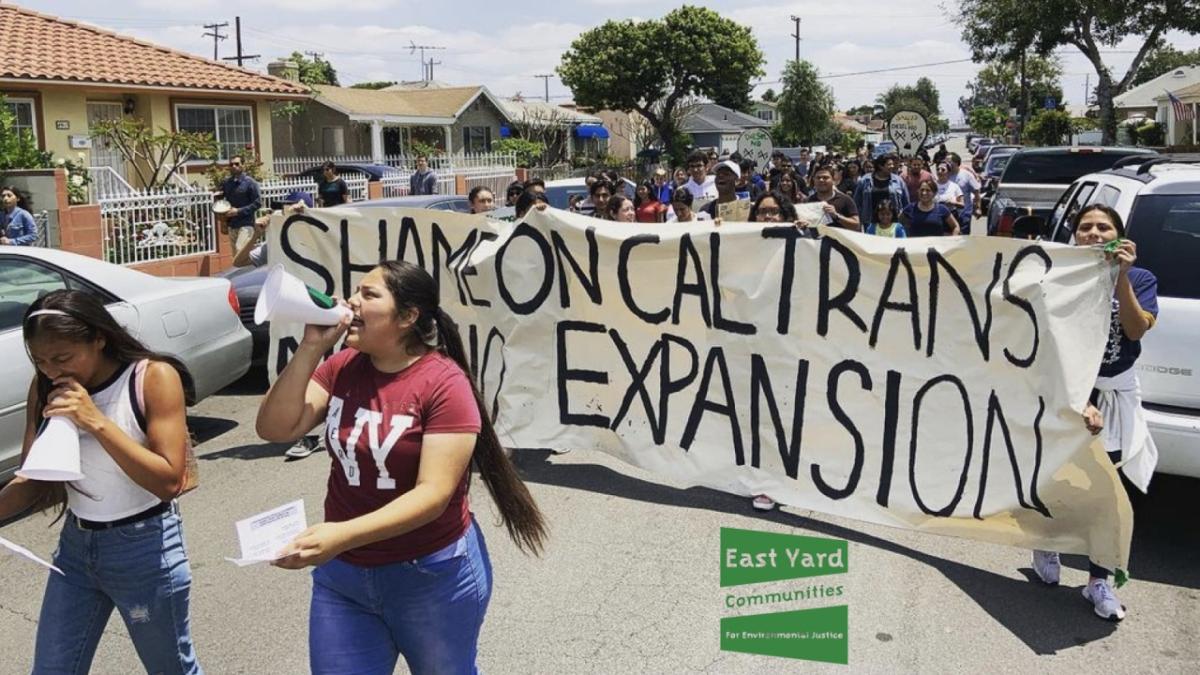Environmental Justice in Los Angeles

The Issue
Growing up in West Long Beach, Jan Victor F. Andasan remembers watching their younger brother take long breaths through a nebulizer to help him breathe easier. In the late nineties, Andasan, who was also an asthmatic and used an inhaler, had immigrated with their family from the Philippines to Southern California. In their predominantly working-class community of color, homes — including Andasan’s — were bordered and bound by some of the biggest and busiest ports, freeways, and refineries in the country. As a child, Andasan was used to the nebulizer, to the railway yard next door, to the fire and black smoke of refinery flares. But some two decades later, as an organizer with East Yards Communities for Environmental Justice (EYCEJ) — a community-based organization that works across Los Angeles’ communities — they are still hearing the same stories.
“No matter how much the air has improved, it’s still not healthy,” they said. “People shouldn’t be living next to this much pollution.”
For communities such as West Long Beach, Wilmington, San Pedro, and Carson — around a 30-minute drive south of downtown Los Angeles — environmental injustice stems from the fossil fuel industry which, for impacted communities, is right on their doorstep. Alongside both the Port of Long Beach and the Port of Los Angeles, there are five oil refineries within the 20-mile radius of Wilmington, two major shipping yards from which containers of goods are transported along the nearby I-710 freight corridor, and active neighborhood oil wells that are often within 1,500 feet of homes, schools, and hospitals.
These exposures have contributed to the Los Angeles-Long Beach area placing within the top 10 cities most polluted by PM2.5 — a type of particle pollution that can move deep into the lungs and spread into the bloodstream. The region is also the worst in the country for ozone pollution (or smog), according to a 2020 report from the American Lung Association. The oil industry is the largest source of volatile organic compound emissions, a group of chemicals that make up most of Los Angeles’ smog. Research has linked both PM2.5 and ozone pollution to a range of health issues including cardiac and respiratory problems, stroke, cancer, and even dementia.
Among children, such as Andasan’s younger brother, the impacts are especially egregious.
In the early 1990s, researchers at the University of Southern California began a longitudinal study tracking the long-term health effects of air pollution on children’s respiratory health. The study has involved more than 12,000 children from 16 communities across Southern California, including the Long Beach area. Among other findings tying increased air pollution to asthma and respiratory infections, the study found that children living in communities with higher pollution levels — namely those from vehicle emissions and fossil fuels – had measurable lung damage, including reduced growth and poor function. However, researchers have also found improvements. A 2015 follow-up study found that as air quality improved across Los Angeles, so too has the lung and respiratory health of its children. While such improvements are often credited to science-based environmental policies — and rightly so — organizers, activists, and frontline communities have played huge a role in making those changes possible.
Making an Impact
For decades, organizations such as EYCEJ and Communities For A Better Environment (CBE) have been organizing and working alongside the low-income communities of color most impacted by environmental justice issues. Since 2013, CBE has been the co-chair of STAND-LA, an environmental justice coalition working to end urban oil extraction. Around 500,000 people in the greater Los Angeles area live within a quarter mile of an active drilling site, exposing residents to a myriad of known carcinogens and endocrine disruptors and contributing to health impacts such as headaches, nosebleeds, nausea, and respiratory illness. For years, STAND-LA has been campaigning for the City of Los Angeles to institute a 2,500-foot safety buffer zone between active wells and communities. While the city released a report in 2019, recommending a 600-foot buffer for existing wells and a 1,500-foot buffer for new wells — falling short of the community’s demands — the coalition has experienced a recent win.
In early December, the Los Angeles City Council’s Environment, Climate Change, and Environmental Justice Committee passed a unanimous motion that directs the City Attorney to draft an ordinance declaring oil and gas extraction sites “non-conforming land uses.” Advocates are optimistic that the motion is a step towards phasing out oil extraction across the region. At the core of this organizing, however, is the need to develop a plan for a just transition. Fossil fuel workers are at the front of the frontline, not only working across Los Angeles’ refineries and oil drilling sites, but also living in those same impacted communities. Through their work as a community organizer, Andasan has heard stories of refinery workers retiring, only to pass a way a year or two later. Many workers, they said, understand why organizations such as EYCEJ lead protests and actions outside the city’s fossil fuel sites. Yet, as working-class people of color, they’ve had to forgo their health to feed their families.
“Why can’t we have clean air? Why can’t we have jobs that don’t impact our environment? Why do we have to choose?,” Andasan said. “As my coworker says, we’ve been the canaries in the coalmine, breathing this air and telling people that it’s bad. Now we need the rest of society to make a shift.”
Want to help? MAKE A DIFFERENCE: DONATE TO THE EarthX Environmental Justice Fund

